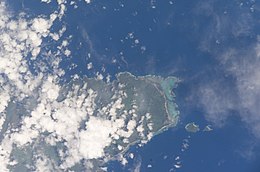geo.wikisort.org - Island
The Aleipata Islands are a group of four uninhabited islands off the eastern end of Upolu Island, Samoa. The islands are eroded volcanic tuff rings, and consist of a small northern pair on Upolu's barrier reef, and a larger southern pair outside it.[1] Collectively the islands have an area of about 1.7 km2 (0.66 sq mi).[2] Administratively, the islands are part of the Atua district. The islands are important for Samoa's biodiversity and are protected by the Aleipata Marine Protected Area.[3]
 Aleipata islands east of Upolu island (NASA) | |
| Geography | |
|---|---|
| Coordinates | 14°04′20″S 171°24′40″W |
| Area | 1.7 km2 (0.66 sq mi) |
| Highest elevation | 180 m (590 ft) |
| Administration | |
| Demographics | |
| Population | Uninhabited |
Geography
From north to south, the islands consist of:
Namua and Fanuatapu lie at the outer edge of the fringing reef of Upolu, at a distance of 0.7 km and 2.5 km, respectively, from Upolu Island itself. Nuʻutele and Nuʻulua are 4 to 6 km further south, outside the fringing reef, and lie 1.4 km 3.5 km off Cape Tapaga, which is the southeastern headland of Upolu. Only Namua is open for visitors, who can enjoy the Namua Island Resort and the beaches. Fanuatapu, being the easternmost island, has a lighthouse.
Environment
The islands are uninhabited and relatively undisturbed, and provide an important refuge for native plant and animal species.[2] The northern islands are mostly bare rock and coastal forest, while the larger southern group are mostly covered by coastal and lowland forest.[2] The islands are home to the largest population of Tongan ground doves in Samoa, as well as Coconut crabs, and provides a nesting place for critically-endangered Hawksbill sea turtles,[4] as wella s birds including the Samoan flycatcher and Manumean.[1]
In 2009 an attempt was made to eradicate the introduced Polynesian rat from the southern islands using air-dropped Brodifacoum to provide a pest-free refuge.[5] The attempt was unsuccessful, with rats being detected again in 2011.[4]
See also
- Samoan Islands
- Geography of Samoa
References
- "Aleipata Islands". OceanDots.com. Archived from the original on 2010-12-23. Retrieved 2009-03-14.
- Whistler, W. Arthur (1983). "Vegetation and Flora of the Aleipata Islands, Western Samoa" (PDF). Pacific Science. 37 (3): 227–249. Retrieved 17 August 2021.
- "Community Integrated Management Plan: Aleipata-Itupa I Luga - Upolu" (PDF). Ministry of Natural Resources and Environment. 2018. p. 12. Retrieved 17 August 2021.
- "Restoration of Nu'utele and Nu'ulua islands (Aleipata group), Samoa, through the management of introduced rats and ants" (PDF). Conservation International. 2013. Retrieved 17 August 2021.
- Parrish, Richard; Sherley, Greg H. (2012). "Birds of the Aleipata Islands, Samoa" (PDF). Notornis. 59: 153-162. Retrieved 17 August 2021.
На других языках
[de] Aleipata-Inseln
Die Aleipata-Inseln sind eine Gruppe von vier unbewohnten Inseln am östlichen Ende von Upolu in Samoa mit einer Gesamtfläche von 1,68 km². Die Inseln sind geologisch gesehen Tuffringe, die zum Teil im Meer versunken sind. Administrativ gehören die vier Inseln zum Bezirk von Atua (Lufilufi). Die beiden nördlichen Inseln (Fanuatapu und Namua) gehören zum Wahlbezirk (faipule) Aleipata Itupa-i-lalo, die beiden südlichen (Nuʻutele und Nuʻulua) zu Aleipata Itupa-i-luga. Auf den Inseln befinden sich die östlichste und die südlichste Landmasse des Staates Samoa.- [en] Aleipata Islands
[ru] Алеипата
Алеипата (англ. Aleipata Islands) — необитаемый архипелаг из четырёх островов общей площадью 1,68 км². Расположен чуть восточнее острова Уполу (округ Атуа, Самоа). Является природоохранной территорией[en], так как здесь обитает множество морских птиц, в том числе исчезающий зубчатоклювый голубь, Myiagra albiventris[en], Alopecoenas stairi[en][1], поэтому на три из четырёх островов свободный доступ запрещён. Все четыре острова являются туфовыми конусами. До островов Нуутеле и Нуулуа можно добраться из деревни Лаломану, до Намуа и Фануатапу — из деревень Малаела, Муиателе и Амаиле.Другой контент может иметь иную лицензию. Перед использованием материалов сайта WikiSort.org внимательно изучите правила лицензирования конкретных элементов наполнения сайта.
WikiSort.org - проект по пересортировке и дополнению контента Википедии
